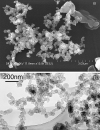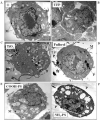Review on nanoparticles and nanostructured materials: history, sources, toxicity and regulations
- PMID: 29719757
- PMCID: PMC5905289
- DOI: 10.3762/bjnano.9.98
Review on nanoparticles and nanostructured materials: history, sources, toxicity and regulations
Abstract
Nanomaterials (NMs) have gained prominence in technological advancements due to their tunable physical, chemical and biological properties with enhanced performance over their bulk counterparts. NMs are categorized depending on their size, composition, shape, and origin. The ability to predict the unique properties of NMs increases the value of each classification. Due to increased growth of production of NMs and their industrial applications, issues relating to toxicity are inevitable. The aim of this review is to compare synthetic (engineered) and naturally occurring nanoparticles (NPs) and nanostructured materials (NSMs) to identify their nanoscale properties and to define the specific knowledge gaps related to the risk assessment of NPs and NSMs in the environment. The review presents an overview of the history and classifications of NMs and gives an overview of the various sources of NPs and NSMs, from natural to synthetic, and their toxic effects towards mammalian cells and tissue. Additionally, the types of toxic reactions associated with NPs and NSMs and the regulations implemented by different countries to reduce the associated risks are also discussed.
Keywords: nanomaterial classification; nanomaterial history; nanotoxicity; oxidative stress; reactive oxygen species; regulations.
Figures









References
-
- United Nations [Aug 21;2014 ];Questions About Nanotechnology. 2012 Available from: https://www.epa.gov/chemical-research/research-nanomaterials.
-
- Considering Whether an FDA-Regulated Product Involves the Application of Nanotechnology. USA: Federal Drug Administration; 2011. [Jan 25;2016 ]. Available from: https://www.fda.gov/RegulatoryInformation/Guidances/ucm257698.htm.
-
- ISO/TS 80004-1:2010, Nanotechnology – Vocabulary – Part 1: Core Terms. Geneva, Switzerland: International Organization for Standardization; 2010. [Jul 17;2017 ]. Available from: https://www.iso.org/standard/51240.html.
-
- Bleeker E A J, Cassee F R, Geertsma R E, et al. Interpretation and implications of the European Commission's definition on nanomaterials; Letter report 601358001. Bilthoven, Netherlands: RIVM; 2012. https://www.rivm.nl/bibliotheek/rapporten/601358001.html.
Publication types
LinkOut - more resources
Full Text Sources
Other Literature Sources
